I’ve been a long-time admirer of the artistic appeal of tracks, trails, burrows, nests, and other traces of animal behavior. My fondness for the beauty of traces also no doubt contributes to my science: after all, the longer I look at a trace, the more I learn about it. This sentiment accords with a long-time principle of paleontology, botany, and other facets of natural history, which is, “If you draw it, you know it,” with the added benefit of expressing your appreciation of natural objects to others through visual depictions.
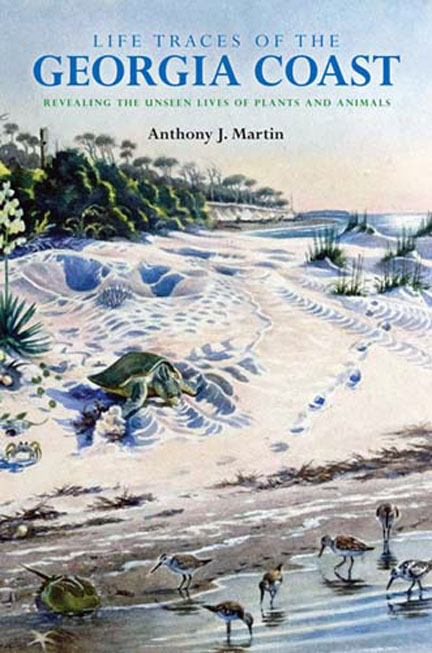 Here it is: the cover for my upcoming book, Life Traces of the Georgia Coast: Revealing the Unseen Lives of Plants and Animals! The book is scheduled to be published by Indiana University Press in the fall of 2012, so be watching out for it then. But in the meantime, look at the beautiful cover art. Who created it, what inspired it, and what science lies behind its aesthetically pleasing composition? Please read on to find out.
Here it is: the cover for my upcoming book, Life Traces of the Georgia Coast: Revealing the Unseen Lives of Plants and Animals! The book is scheduled to be published by Indiana University Press in the fall of 2012, so be watching out for it then. But in the meantime, look at the beautiful cover art. Who created it, what inspired it, and what science lies behind its aesthetically pleasing composition? Please read on to find out.
My thinking about traces as objects of art is not very original, though, and in fact has been preceded by most of humanity. For example, animal tracks and other traces were common subjects of rock art extending back to the Pleistocene Epoch. Whether made as pictographs or petroglyphs, these traces of traces are in Australia, southern Africa, Australia, and Europe, with some tens of thousands of years old. Based on this tantalizing evidence, one could reasonably propose that the representation of animal traces through art composes an intrinsic part of our heritage as a species. Yes, I know, that’s a tough hypothesis to pursue any further. So I’ll leave it to my paleoanthropologist colleagues to work out (or not).
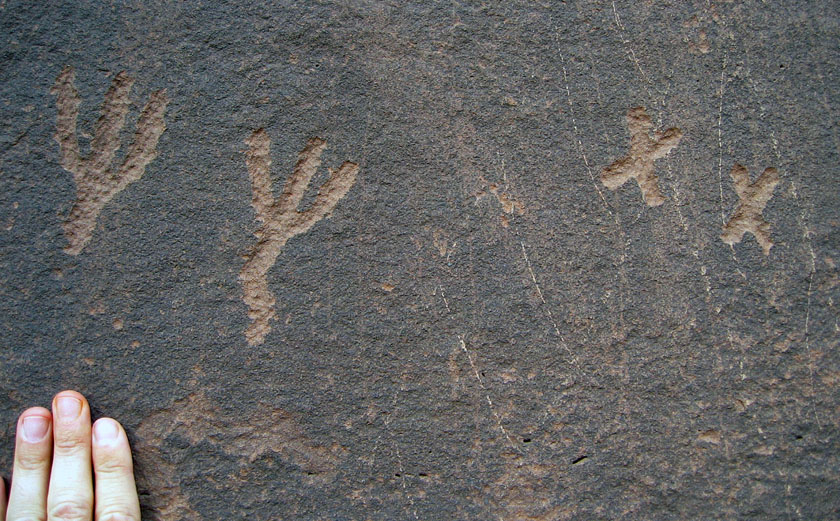 Petroglyphs that likely represent bird tracks, etched in Triassic sandstone by Native Americans hundreds of years ago (sorry, I’m a paleontologist, not an archaeologist). The pair of marks on the right is similar to the tracks made by a perching bird with three forward pointing toes and one rearward-pointing toe – such as an eagle – whereas those to the right may be like those of a roadrunner, which has an X-shaped foot. Petroglyphs are in northeastern Arizona, near Petrified Forest National Park.
Petroglyphs that likely represent bird tracks, etched in Triassic sandstone by Native Americans hundreds of years ago (sorry, I’m a paleontologist, not an archaeologist). The pair of marks on the right is similar to the tracks made by a perching bird with three forward pointing toes and one rearward-pointing toe – such as an eagle – whereas those to the right may be like those of a roadrunner, which has an X-shaped foot. Petroglyphs are in northeastern Arizona, near Petrified Forest National Park.
Much more recently, trace fossils similarly inspired renowned ichnologist Dolf Seilacher, who also saw these vestiges of past behavior as lovely objects that fill us with wonder. As a result, in the mid-1990s, he conceived of a traveling exhibit and book showcasing tableaus of trace fossils and other sedimentary structures, titled Fossil Art. For this show – embraced by natural-history venues but mostly rejected by art museums – Seilacher prepared it by: (1) making latex molds of sedimentary rock surfaces; (2) pouring epoxy resin into the molds to make casts mimicking the original bedding planes; and (3) using indirect lighting to enhance details; and (4) assigning creative titles to each piece as if they were works of art.
So these artificial slabs are not human-made art in the traditional sense, but nonetheless invoke marvel, project splendor, and otherwise make us think, engaging the same senses and thought processes that accompany an appreciation of art. Moreover, the slim book Seilacher authored for the exhibit contains explanatory text about each of the objects, illuminated further by his marvelous illustrations and visual interpretations. I remember first seeing a version of this exhibit in Holzmaden, Germany in 1995, near Seilacher’s home in Tubingen, and most lately enjoyed strolling through it with other many ichnologists – and Seilacher himself – in Krakow, Poland in 2008.
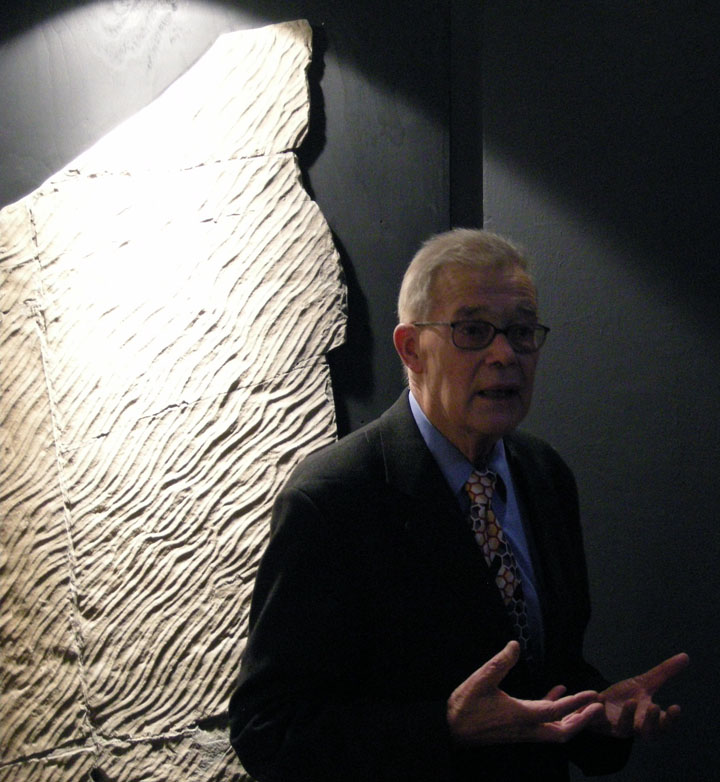 World-renowned ichnologist and (oh yeah) Crafoord Prize winner, Dolf Seilacher, lecturing about the planning and execution of Fossil Art as an exhibit while it was showing at the Geological Museum of Jagiellonian University in Krakow, Poland in September 2008. Photograph by Anthony Martin.
World-renowned ichnologist and (oh yeah) Crafoord Prize winner, Dolf Seilacher, lecturing about the planning and execution of Fossil Art as an exhibit while it was showing at the Geological Museum of Jagiellonian University in Krakow, Poland in September 2008. Photograph by Anthony Martin.
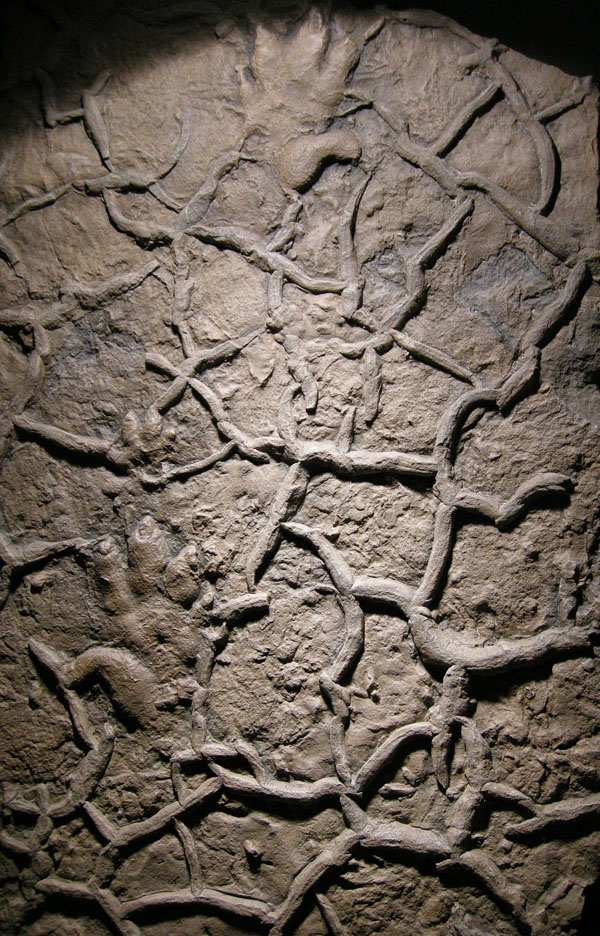 A close-up of Wrong Sided Hands, one of the pieces displayed in Fossil Art, cast from a latex mold of a sample from Lower Triassic Buntsandstein of Germany. The piece is so-called because the false appearance of a “thumb” on the outside of the tracks originally led to the mistaken idea that the animal awkwardly crossed its own path with each step. This turned out to be wrong. Also, check out the mudcracks! Photograph by Anthony Martin.
A close-up of Wrong Sided Hands, one of the pieces displayed in Fossil Art, cast from a latex mold of a sample from Lower Triassic Buntsandstein of Germany. The piece is so-called because the false appearance of a “thumb” on the outside of the tracks originally led to the mistaken idea that the animal awkwardly crossed its own path with each step. This turned out to be wrong. Also, check out the mudcracks! Photograph by Anthony Martin.
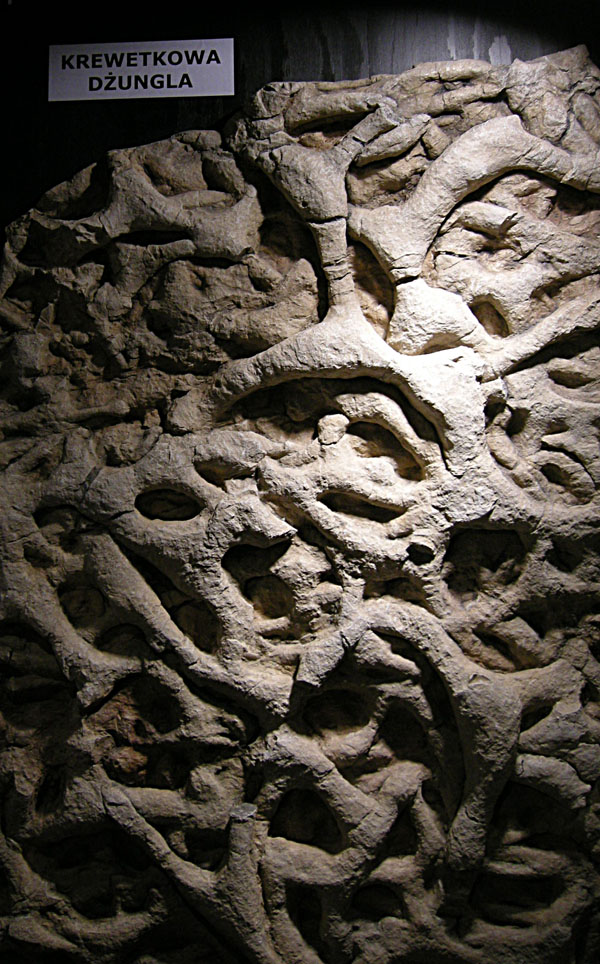 Another close-up of a piece from Fossil Art, titled Shrimp Burrow Jungle (helpfully translated into Polish here). This one is based on burrow systems made by crustaceans during the Late Triassic in Italy, which became densely populated over time and hence contributed to overlapping systems. Photograph by Anthony Martin.
Another close-up of a piece from Fossil Art, titled Shrimp Burrow Jungle (helpfully translated into Polish here). This one is based on burrow systems made by crustaceans during the Late Triassic in Italy, which became densely populated over time and hence contributed to overlapping systems. Photograph by Anthony Martin.
Hence during my writing of a book about the modern traces of the Georgia barrier islands, I was well aware of how some of these traces could likewise lend to artistic expression. Some of this mindfulness was applied to a collaborative artwork done with my wife, Ruth Schowalter, in which we took an illustration of mine from the book and used it as the inspiration for a large watercolor painting depicting traces that would form with rising sea level along the Georgia coast (discussed in detail here).
Nonetheless, it was especially important to think about traces as art when considering a potential cover for the book. Book authors know all too well that a well-designed, attractive cover is essential for grabbing the attention of a potential reader, so I had that practical consideration in mind. But I also wanted a cover that pleased me personally, sharing my love of beautiful traces with others, especially those varied and wondrous tracks, burrows, and trails I had seen and studied on the Georgia barrier islands during the past 15 years.
In such an endeavor, I also faced the added pressure of precedence set by my publisher, Indiana University Press. My book is part of a series by IU Press, called Life of the Past, which is widely admired not only for its comprehensive coverage of paleontological topics, but also for its fine cover art, showcasing works done by a veritable “who’s who” of “paleoartists,” So I knew the cover art for my book needed to both conform to this legacy of artistic excellence, but also stand out from other books in the series because of its unique themes. After all, this would be first book in Life of the Past focusing specifically on ichnology. Moreover, the book is more concerned on modern tracemakers and their environments, rather than plants and animals of pre-human worlds. This was done with the intention of demonstrating how our knowledge of modern traces helps us to better understand life from the geologic past, an intrinsic principle of geology called uniformitarianism.
Ideally, as an ichnological purist, I would have had a cover devoid of any animals, and just shown environments of the Georgia of the Georgia coast with their traces. Indeed, I did just that in some of my illustrations in the book, in which I purposefully omitted animals and left only their traces. This “ichno-centric” mindset actually serves a pedagogical purpose, in that it would echo the truism that many sedimentary rocks are devoid of body fossils, yet are teeming with trace fossils.
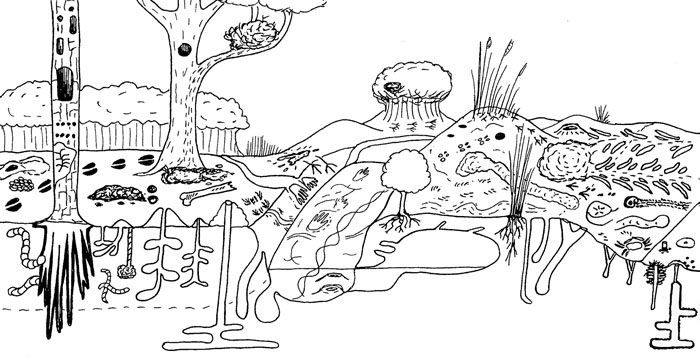 Figure 1.3 from Life Traces of the Georgia Coast, conveying a sense of the variety and abundance of traces on a typical Georgia barrier island, from maritime forest (left) to shallow intertidal (right). I purposefully drew this illustration using a more cartoonish technique to introduce broad search images of traces for people who may not ordinarily think about these. But also notice what’s missing from the figure: the animal tracemakers. Instead, only immobile plants are depicted. Would this make for good cover art? No and no, especially if you’ve seen the typical covers done for Indiana University Press books. Illustration by Anthony Martin.
Figure 1.3 from Life Traces of the Georgia Coast, conveying a sense of the variety and abundance of traces on a typical Georgia barrier island, from maritime forest (left) to shallow intertidal (right). I purposefully drew this illustration using a more cartoonish technique to introduce broad search images of traces for people who may not ordinarily think about these. But also notice what’s missing from the figure: the animal tracemakers. Instead, only immobile plants are depicted. Would this make for good cover art? No and no, especially if you’ve seen the typical covers done for Indiana University Press books. Illustration by Anthony Martin.
Realistically, though, I also knew that modern traces, particularly those made in places as easy to visit as parts of the Georgia coast, would be more eye-catching if accompanied by some of their charismatic tracemakers in a beautiful, natural setting. After all, the Georgia coast has lengthy sandy beaches, dunes, maritime forests, and salt marshes, inhabited by a wide variety of animals, such as sea turtles, shorebirds, alligators, horseshoe crabs, ghost crabs, and many others.
I also knew that a paleoartist would not be as well suited to the task of creating a cover as someone who works more with modern environments. A better pick would be someone who was familiar with the landscapes, plants, and animals of the Georgia barrier islands, but also a fine artist. I briefly toyed with the idea of doing it myself, but already felt like far too much of the book had been “DIY,” and was not confident enough in my skills to put together a compelling cover in enough time before the book came together. An artfully done photograph was another possibility, so I sent several prospective examples to the editors for their appraisal, but these were all shot down for not having enough aesthetic elements for an attention-getting cover (i.e., traces + landscapes + sky + water = very difficult to get into a single photo).
Fortunately, through social connections that still happen despite the Internet and its incentives for becoming increasingly introverted, I met Alan Campbell through mutual friends in December 2008 at a dinner party on the Georgia coast. Fortuitously enough, our meeting was also just before Ruth and I did three weeks of field work on the barrier islands for the book. It was only fitting, then, that our first meeting was spent dining with both of us facing a Georgia salt marsh, filled with fiddler crab burrows and other such traces. Alan is a Georgia artist with much life experience along its coast, he has often portrayed its environments through gorgeous watercolors, and he has worked with scientists in the field.
Consequently, I kept Alan in mind as a potential cover artist for the next few years, and after I had finished the text and all figures for the book, I contacted him last year about my idea, while simultaneously suggesting him to the editors at IU Press. After much back-and-forth negotiations, with me in the middle, both parties finally came to an agreement, and Alan had a contract to do the artwork for the cover by December 2011.
To help Alan in researching his task, I sent him all of my illustrations and photos used in the book so that he would have an extensive library of trace images on hand for reference. He also had this blog as a source, in which I regularly write about Georgia-coast traces, explanations that are always accompanied by photographs and an occasional illustration. We also exchanged many e-mails and talked on the phone whenever needed. I told Alan my preferred cover would feature a coastal scene, but one filled with traces. He voiced a concern that the painting might become too “busy,” and the details might be lost in reduction of the image to the size
Alan’s contract specified that he would have preliminary study sketches would be done by February 1, and the final cover art was to be finished by March 30. He was only a little late with the study sketches (delayed by a minor operation), and I was delighted to see the following sketch in mid-February.
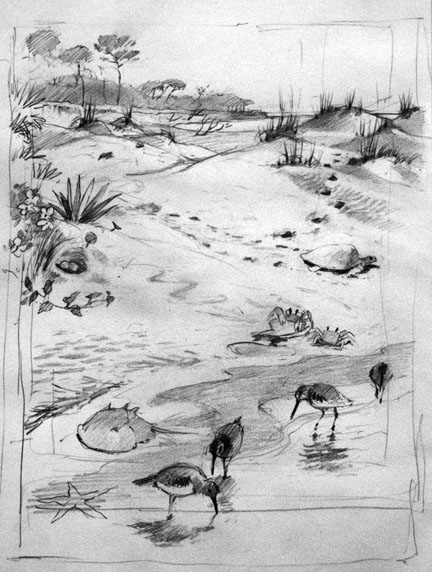 Study sketch by Alan Campbell for the cover of Life Traces of the Georgia Coast. Reprinted with his permission, and anyone else who want to use it, you have to ask him, too. By the way, every time you use original artwork without permission, a little kitten dies.
Study sketch by Alan Campbell for the cover of Life Traces of the Georgia Coast. Reprinted with his permission, and anyone else who want to use it, you have to ask him, too. By the way, every time you use original artwork without permission, a little kitten dies.
After a little bit of feedback from both me and graphic designers at IU Press, Alan went back to the drawing board (so to speak), and came up with the following watercolor painting.
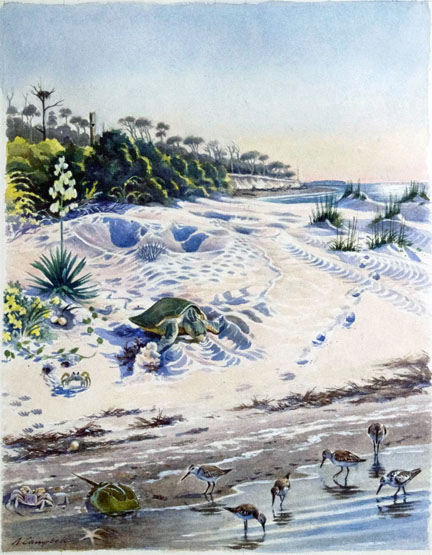 Life Traces of the Georgia Coast, 2012, watercolor on paper, 14” X 18” by Alan Campbell. Again, if you want to use it, you have to ask him first and get permission. Remember those kittens? They’re alive now, but there’s no guarantee they’re going to stay that way.
Life Traces of the Georgia Coast, 2012, watercolor on paper, 14” X 18” by Alan Campbell. Again, if you want to use it, you have to ask him first and get permission. Remember those kittens? They’re alive now, but there’s no guarantee they’re going to stay that way.
I gave this artwork a big thumbs up, as did the people at IU Press. So once approved and the scan was sent to IU Press, it was up to the graphic designers there to pick out the typeface, color of the type for the main title, subtitle, author name, and placement of type without covering up the main composition of the painting. I had no say in this, and that’s a good thing, because they really knew what they were doing. It is a very nicely designed cover, and the only thing that would please me more is if they had produced a holographic image of it. (Maybe next year.)
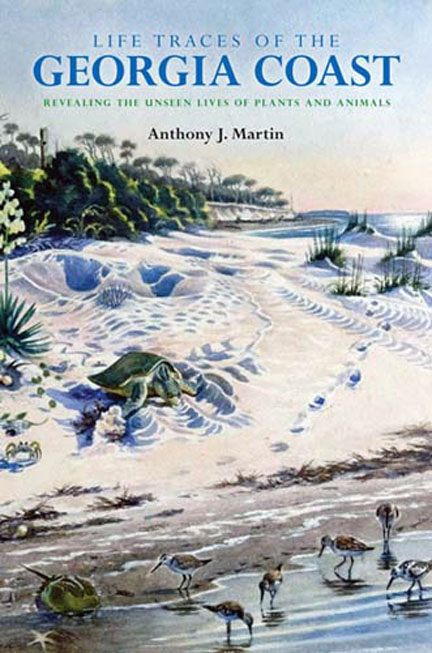 The final cover art for Life Traces of the Georgia Coast revisited. Does it look a little different, now that you know more about how it came about?
The final cover art for Life Traces of the Georgia Coast revisited. Does it look a little different, now that you know more about how it came about?
I won’t spoil the fun for potential readers, scientists, and art appreciators by explaining in detail all of the ichnological, ecological, and geological elements incorporated into the cover. After all, I’d like to sell a few copies of the book, while also letting readers make their own personal discoveries. But hopefully all of you now have a better appreciation for how traces made by animals, our recognition and admiration for these, and artistic expression of them can all combine to contribute to a book that can be accurately judged by its cover.
Further Reading
Leigh, J., Kilgo, J., and Campbell, A. 2004. Ossabaw: Evocations of an Island. University of Georgia Press, Athens, Georgia.
Martin, A.J., in press. Life Traces of the Georgia Coast: Revealing the Unseen Lives of Plants and Animals. Indiana University Press, Bloomington, Indiana.
Morwood, M.J. 2002. Visions from the Past: The Archaeology of Australian Aboriginal Art. Allen & Unwin, Sydney, Australia.
Seilacher, A. 2008. Fossil Art: An Exhibition of the Geologisches Institut. Tubingen University, Tubingen, Germany.
Tomaselli, K.G. 2001. Rock art, the art of tracking, and cybertracking: Demystifying the “Bushmen” in the information age. Visual Anthropology, 14: 77-82.
